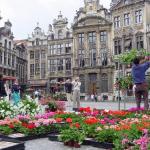Sights Brussels, Belgium
 Brussels for several centuries was the capital of a rich and prosperous Brabant, and after the founding of the Belgian state - the largest center and seat of government of the Kingdom of Belgium. On the face of the city, as embodied in the monumental buildings that surround the so-called House of the King, left their mark prosperous merchants and craftsmen of the city's shops and guilds. In the last quarter of XX century the town was covered new construction boom. NATO and the EU, based in Brussels, the city built around a ring of tall buildings and turned the old merchants' town in the administrative capital of Europe.
Brussels for several centuries was the capital of a rich and prosperous Brabant, and after the founding of the Belgian state - the largest center and seat of government of the Kingdom of Belgium. On the face of the city, as embodied in the monumental buildings that surround the so-called House of the King, left their mark prosperous merchants and craftsmen of the city's shops and guilds. In the last quarter of XX century the town was covered new construction boom. NATO and the EU, based in Brussels, the city built around a ring of tall buildings and turned the old merchants' town in the administrative capital of Europe.On the outskirts of Brussels, ascended to heaven coated aluminum panels scope of the famous Atomium. This quaint building was erected for the World Exhibition of 1958 and on a plan of its founders was to symbolize man's knowledge of atomic structure. From the observation platform Atomium, located on nearly 100-meter height, opens a broad panorama of Brussels and its suburbs.
However, to understand the nature of the city really, it is necessary to change the observation deck of the Atomium on the cobblestones of the historical center of Brussels - Grand dance. That's where all acutely felt the charm of the old Brussels - stone carving at City Hall, its apparent air-tall central tower, exquisite ornaments and bas-reliefs of the merchant guild houses, dark houses gilded king - all tunes on the elevated mood. Wonder Gran dance is considered one of the most beautiful urban areas of Western Europe. The stones of the old area have seen a lot.
One of the attractions of Brussels is the City Hall. It appeared there in the 15 th century - was built in three stages and it came out skewed. The left wing, longer, was built in 1402, right - in 1445, and the tower itself is surmounted by a spire in 1450.
Later, in the 16 century, in front of City Hall was built house of the king. Here placed alternately grain market, tribunals, prison. Now King is located in the house the municipal museum. Mercantile buildings were built in 17 century. They were placed close to each other, like old books in expensive patterned bindings. They will not find any reason to suspect the two identical parts: everything from the roof to the window frames, original and unique. And we need all of them soaring high on the steeple tower tracery City Hall St Michel - the patron of Brussels.
Near Grand dance, at the intersection of two streets, in the corner is the famous Fountain of Manneken Peace "(" Manneken Pis "). Bronze boy very uncomplicated way to fill the sink fountain almost four centuries. One legend says that once the three-year bryusselets exactly put out the fire, which threatened to destroy the city, for which he received a memorial from grateful citizens. This statue became a symbol of Brussels. Kings, presidents and celebrities flashes "Manneken Pis" together, so that today, his wardrobe consists of more than 2000 toilets and stored in the municipal museum.
The world-renowned museum of Mini-Europe is located in Bruparke, where an area of about 2 hectares exhibited more than a hundred models of historical and architectural monuments, carried out in 1:25 scale.
Some of the most revered temples of Brussels - Cathedral of St. Michael, and one of the oldest temples in the Belgian capital - the Church of the Virgin Mary at the Sablon (ie, on a sandy hill), renowned for its stained glass windows and the 14 th century statue of the Virgin and Child.
Cathedral of St. Michael's until quite recently was named collegiate church of St. Michael and St. Gudule. Despite the changes in the name of Brussels still remember St. Gudula. This young and pious dweller Brussels intrusive without disturbed at night to read religious books - every now and then blew out the candle. Girl every time once again to light a candle, and for that his constancy was canonized.